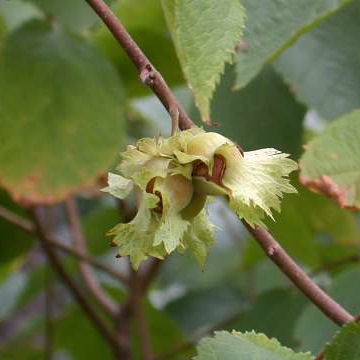

Corylus americana - (image 1 of 5)
Taxonomy
Family: Betulaceae
Habitat
Dry or moist woods, thickets, and oak savannas.
Associates
Amphicarpaea bracteata, Carya ovata, Cornus racemosa, Fragaria virginiana, Fraxinus americana, Geranium maculatum, Osmorhiza claytonii, Potentilla simplex, Prunus serotina, Quercus alba, Quercus rubra, Sanicula gregaria, Smilacina racemosa.
Distribution
ME west to Saskatchewan, south to GA, LA, and OK.
Morphology
A robust, suckering shrub to 3 m; petioles and twigs glandular; buds imbricate, rounded, gray, pubescent. Leaves alternate, simple, to 6" long, broad-ovate to broad-elliptic, serrate. Male flowers yellow-brown, in catkins. Female flowers inconspicuous with red stigma and style protruding from bud. Fruit a nut surrounded by two large bracts.
Notes
Flowers early March to late April.
Wetland indicator: Facultative Upland -
The female flowers, though extremely small, are a beautiful ruby red. The nuts are rather small but similar in flavor to commercial filberts. Dirr suggests that the species is too large a shrub for contemporary landscapes, although I find it makes a nice hedge. The foliage is dense, deep green in summer and fall color can be good yellow-bronze.
References
Dirr, Michael A. 1998. Manual of Woody Landscape Plants:
Their Identification, Ornamental Characteristics, Culture, Propagation and Uses.
5th ed. Champaign, Illiois: Stipes Publishing L.L.C.
Gleason, Henry A.
and A. Cronquist. 1991. Manual of Vascular Plants of Northeastern United States
and Adjacent Canada. Second Ed.
The New York Botanical Garden. Bronx, NY
Swink, F. and G. Wilhelm. 1994. Plants of the Chicago Region.
Indiana Academy of Science. The Morton Arboretum. Lisle, Illinois.
|
Michael Hough © 2004 |